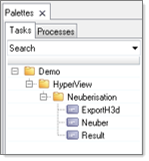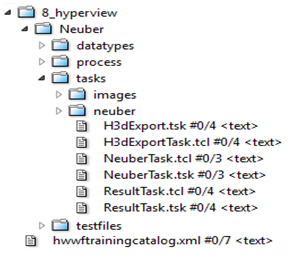Overview of Catalog File Elements and Attributes
- Catalog File Display
- The Task Browser reads in a catalog file and displays it in a tree view.

Figure 1. Catalog File Named Neuberisation - Catalog File Script
- The following is the script for the Neuberisation catalog
file:
<HWAutomate Version="1"> <Register Path="8_hyperview/Neuber/tasks" /> <Domain Name="Demo"> <Group Name="HyperView"> <Category Name="Neuberisation"> <Task Name="Result" /> <Task Name="Neuber" /> <Task Name="ExportH3d" /> <Process Name="Neuberisation" Path="8_hyperview/Neuber/process/Neuberisation.prs" /> </Category> </Group> </Domain> <Data> <DataType Name="Demo::DemoResult" Path="8_hyperview/Neuber/datatypes/Results.tcl"/> </Data> </HWAutomate> - Elements and Attributes of a Catalog XML File
-
Catalog File Attribute Valid Type Function of the XML Attribute Type Register Path= “8_hyperview/Neuber/tasks” user-defined Specifies the folder where the task files resides. This is a relative path from where the catalog file is placed. In this example the task folder is located in the directory 8_hyperview/Neuber/tasks relative to the catalog file.
Figure 2.Note: The catalog file hwwftrainingcatalog.xml is at the same level as 8_hyperview, and the tasks folder is located under 8_hyperview/neuber/.Domain name= “Demo” user-defined Provides a directory level to categorize a group of tasks. An example of domain is Durabity or NVH. In this example the Name is Demo.
Group name= “HyperView” user-defined Provides a directory level to categorize a group of tasks under Domain. An example of Group under Durability would be Signal Processing. In this example the Name is “HyperView”.
Category name= “Neuberisation” user-defined Provides a logical grouping and display of tasks under Category. An example Category under Durability/Signal Processing is “Math” which would contain all the math tasks related to Durability, such as rainflow and peak valley extraction. In this example the name defined is “Neuberisation”.
Task name= “Neuber” Task defined in the .tsk file References the attribute name as defined in the task (.tsk) file. Datatype Name= ”Demo::DemoResult” user-defined Assigns a default value to the variable. In this example the variable name is assigned a default value of “ADD”.
Path= ”8_hyperview/Neuber/process/Neuberisation.prs” user-defined Specifies the path where the process file resides. This is a relative path from where the catalog file is placed. In this example the process file is placed in 8_hyperview/Neuber/process/Neuberisation.prs relative to the catalog file.Note: The catalog file hwwftrainingcatalog.xml is at the same level as 8_hyperview, and the process file is under 8_hyperview/Neuber/process/Neuberisation.prs.Datatype Name=”Neuberisation” user-defined This is the name displayed in the Process Browser. Path=”8_hyperview/Neuber/datatypes/Results.tcl” string int
double
Specifies the path where the datatype file resides. This is a relative path from where the catalog file is placed. In this example the process file is placed 8_hyperview/Neuber/datatypes/Results.tcl relative to catalog file.Note: The catalog file hwwftrainingcatalog.xml is at the same level as 8_hyperview, and the datatype file is under 8_hyperview/Neuber/datatypes/Results.tcl.